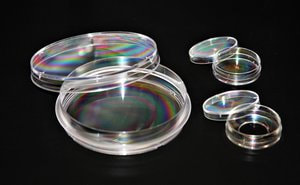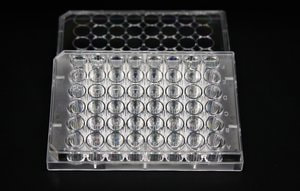PrimeCoat series
The ExCellness PrimeCoat series is designed specifically to provide a biomimetic cell culture environment that improves cell characteristics and phenotype in laboratory applications.
Key features
Biomimetic cell culture substrates at reach
PrimeCoat series combines simplicity and accessibility:
- PrimeCoat elastic substrates are easy to use for cell culture and subsequent analysis.
- PrimeCoat elastic substrates are available with 6 degrees of softness within the elasticity range of body tissues: 2, 5, 10, 15, 30 and 100 kPa.
- PrimeCoat elastic substrates are available in 4 standard formats: 100 mm diameter dishes, 35 mm diameter dishes, 24-well plates and 35 mm diameter dishes with an ultra-thin glass bottom.
- PrimeCoat elastic substrates require to be coated by the end user to promote cell adhesion.
- PrimeCoat elastic substrates are transparent. Cells can be visualized with standard transmission light microscopes (e.g., Phase contrast, DIC).
- PrimeCoat elastic substrates are compatible with most standard molecular or cellular techniques: immunofluorescence, immunohistochemistry, protein analysis (e.g., Western blotting, and RNA/DNA extraction).
Biomimetic cell culture substrates at reach
PrimeCoat series combines simplicity and accessibility:
- simplicity of cell handling
- straightforward compatibility with cell analysis tools
- accessible prices
ExCellness in selected peer reviewed publications
In the following peer-reviewed publications, ExCellness biomimetic cell culture devices have been used or cited:
In the following peer-reviewed publications, ExCellness biomimetic cell culture devices have been used or cited:
- S. Clippinger et al. Mechanical dysfunction induced by a hypertrophic cardiomyopathy mutation is the primary driver of cellular adaptation. doi.org/10.1101/2020.05.04.067181
- N. Landry et al. An Improved Method of Maintaining Primary Murine Cardiac Fibroblasts in Two-Dimensional Cell Culture. Nature Scientific Reports, volume 9, Article number: 12889 (2019)
- M. Lodyga et al. Cadherin-11–mediated adhesion of macrophages to myofibroblasts establishes a profibrotic niche of active TGF-β. Sci. Signal. 2019 12, eaao3469
- A. Elbediwy et al. Enigma protein regulate YAP mechanotransduction. J Cell Sci 2018 131: jcs221788
- F. Klingberg et al. The fibronectin ED-A domain enhances recruitment of latent TGF-β-binding protein-1 to the fibroblast matrix. J Cell Sci 2018 131: jcs201293
- J. Weldrick et al. A rapid and efficient method for the isolation of postnatal murine cardiac myocyte and fibroblast cells. Canadian Journal of Physiology and Pharmacology, vol. 96, no. 5, 2018, p. 535
- B. Liu et al. Increased substrate stiffness elicits a myofibroblastic phenotype in human lamina cribrosa cells. Investigative Ophthalmology & Visual Science February 2018, Vol.59, 803-814. doi:10.1167/iovs.17-22400
- J. Weldrick et al. A rapid and efficient method for the isolation of postnatal murine cardiac myocyte and fibroblast cells. Revue canadienne de physiologie et pharmacologie, 2018, 96(5): 535-539
- N Elkhatib et al. Tubular clathrin/AP-2 lattices pinch collagen fibers to support 3D cell migration. Science. 16 Jun 2017: Vol. 356, Issue 6343, eaal4713
- Y Attieh et al. Cancer-associated fibroblasts lead tumor invasion through integrin-β3–dependent fibronectin assembly. J Cell Biol. 2017 Nov 6; 216(11): 3509–3520.
- A Glentis et al. Cancer-associated fibroblasts induce metalloprotease-independent cancer cell invasion of the basement membrane. Nat Commun. 2017 Oct 13;8(1):924.
- N Vedrenne et al. Isolation of astrocytes displaying myofibroblast properties and present in multiple sclerosis lesions. Neurochem. Res. 2017 Apr 22.
- X L Chen et al. MicroRNA-21 preserves the fibrotic mechanical memory of mesenchymal stem cells. Nature Materials 16, 379–389 (2017).
- MR Zeglinski et al. Chronic expression of Ski induces apoptosis and represses autophagy in cardiac myofibroblasts. Biochim. Biophys. Acta. 2016 Jun;1863(6 Pt A):1261-8.
- H Chen et al. Mechanosensing by the α6-integrin confers an invasive fibroblast phenotype and mediates lung fibrosis. Nat. Commun. 2016 Aug 18;7: 12564.
- NP Talele et al. Expression of α-Smooth Muscle Actin Determines the Fate of Mesenchymal Stromal Cells. Stem Cell Reports. 2015 Jun 9;4(6) : 1016-30.
- V Sarrazy et al. Integrins avb5 and avb3 promote latent TGF-beta 1 activation by human cardiac fibroblast contraction. Cardiovasc Res (2014) 102 (3)
- VF Achterberg et al. The nano-scale mechanical properties of the extracellular matrix regulate dermal fibroblast function.J Invest Dermatol. 2014 Jul;134(7):1862-72.
- JA Cadby et al. Differences between the Cell Populations from the Peritenon and the Tendon Core with Regard to Their Potential Implication in Tendon Repair. 2014. PLoS ONE 9(3): e92474.
- T. Grand et al. Aggravation of Cardiac Myofibroblast Arrhythmogeneicity by Mechanical Stress. Cardiovasc Res. 2014 Dec 1;104(3):489-500.
- JA Cadby. Can we improve tendon healing in the horse? A multi-angle study of a multi-facet problem. ISBN: 978-90-5335-715-6.
- A Vashist et al. Recent advances in hydrogel based drug delivery systems for the human body. J. Mater. Chem. B, 2014,2, 147-166.
- T. Grand et al. Aggravation of Cardiac Myofibroblast Arrhythmogeneicity by Mechanical Stress. https://boris.unibe.ch/62065/1/Grand_manuscript_2014.pdf
- EP van der Veer et al. The RNA-Binding Protein Quaking is a Critical Regulator of Vascular Smooth Muscle Cell Phenotype. Circ Res. 2013 Oct 12;113(9):1065-75.
- A De Boeck et al. Differential secretome analysis of cancer-associated fibrobroblasts and bone marrow-derived precursors toidentify microenvironmental regulators of colon cancerprogression. Proteomics 2013,13,379-388.
- C Godbout et al. The Mechanical Environment Modulates Intracellular Calcium Oscillation Activities of Myofibroblasts. PLoS One. 2013; 8(5): e64560.
- S Constant et al. Colon Cancer: Current Treatments and Preclinical Models for the Discovery and Development of New Therapies. Drug discovery; Editor Hany A. El-Shemy. ISBN 978-953-51-0906-8.
- JL Balestrini et al. The mechanical memory of lung myofibroblasts. Integr. Biol. 2012,4, 410-421.
- Stem Cells and Cancer Stem Cells, Volume 8. Therapeutic Applications in Disease and Injury. Editors M.A. Hayat. ISBN 978-94-007-4797-5.
- A Skardal et al. Bioprinted amniotic fluid-derived stem cells accelerate healing of large skin wounds. Stem Cells Transl Med. 2012 Nov;1(11):792-802. doi: 10.5966/sctm.2012-0088. Epub 2012 Oct 29.
- A Skardal et al. Substrate elasticity controls cell proliferation, surface marker expression and motile phenotype in amniotic fluid-derived stem cells. J Mech Behav Biomed Mater. 2013 January; 17: 307-316.
- BJ Crider et al. Myocardin-Related Transcription Factors A and B Are Key Regulators of TGF-b1-Induced Fibroblast to Myofibroblast Differentiation. Journal of Investigative Dermatology (2011) 131, 2378-2385.
- L Follonier Castella et al. A new lock-step mechanism of matrix remodelling based on subcellular contractile events. Journal of Cell Science 123, 1751-1760.

